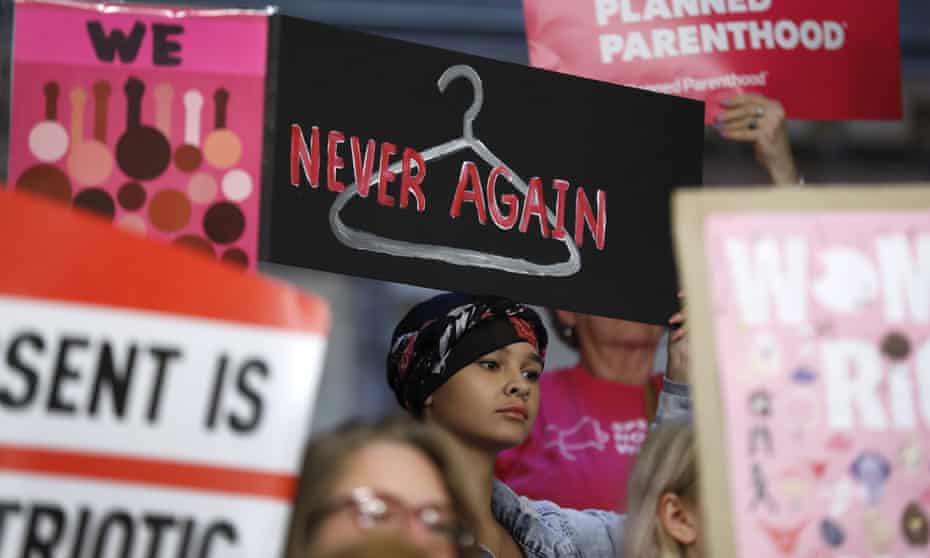Rate of US abortions drops to lowest level since 1973
This article is more than 2 years old
The US experienced an 8% decline in the abortion rate in three years, to the lowest recorded level since abortion was legalized

August Mulvihill, of Norwalk, Iowa, center, holds a sign during a rally to protest recent abortion bans, in Iowa on 21 May 2019. Photograph: Charlie Neibergall/AP
Jessica Glenza in New York
@JessicaGlenza
Wed 18 Sep 2019 12.54 EDTLast modified on Wed 18 Sep 2019 14.15 EDT
The overall rate of abortions has dropped in the US to the lowest level since 1973, according to a new study, continuing a downward trend.
The US experienced an 8% decline in the abortion rate in three years, to 13.5 abortions per 1,000 women aged 15-44, the lowest recorded level since abortion was legalized in 1973. In 2017, an estimated 862,320 abortions were performed.
The research comes as states have enacted dramatic attempts to outlaw abortion, but researchers said a declining US fertility rate and use of long-acting birth control are more likely responsible for the national drop. Rather, restrictions on abortion clinics have shifted where women can obtain abortions.
“Abortion access, as measured by the number of clinics, has become more polarized,” said Rachel Jones, lead author of the report from Guttmacher Institute, a reproductive health resesarch institute. It is the organization’s 18th census of abortion providers in the US, and covers the years 2014-2017.
The study found 9% of clinics in the South shuttered in those three years, and the Midwest had 6% fewer clinics, likely due to restrictions on how clinics can operate. In turn, the number of clinics in the Northeast and West have grown by 16% and 4% respectively.
The study found the number of abortion clinics nationally had grown from 789 to 808, but this figure has already changed. In just one example, two abortion clinics in Missouri were forced to close since 2017.
“Individuals living in the midwest and south already have to deal with numerous abortion restrictions, and having fewer clinics that provide this care can put abortion out of reach for some groups, particularly low-income individuals,” said Jones.
Notably, the study does not measure how many women leave their home state to terminate a pregnancy. However, previous studies have found in the five states with the lowest abortion rates, as much as 28% of women may be traveling out-of-state to gain access to the procedure.
Those five states – Idaho, Kentucky, Missouri, South Dakota, and Wyoming – are all rural and conservative. Kentucky, Missouri and South Dakota each have only one abortion clinic.
Both Kentucky and Missouri passed unconstitutional abortion bans in 2019, which are being challenged in court. Neither law is likely to go into effect. Abortion is legal in all 50 states.
The lower abortion rate continues a long trend of women using more effective, long-acting birth control, such as intrauterine devices, and of a declining US fertility rate. In 2018, the US fertility rate dropped to an all-time low, which some argue is the effect of women delaying pregnancy.
Researchers also said more women could be managing their own abortions at home, likely with medication abortions. Estimating the number of women who manage abortions outside of clinics and doctor’s offices is difficult and at times contradictory.
In 2018, the international organization Aid Access said it provided 2,500 prescriptions for medication abortions to patients in the US, but a national survey of adult women found just 1.4% of women had ever attempted to an a pregnancy on their own, including many before 2000.
theguardian.com |





